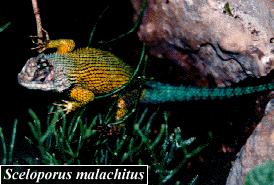Sceloporus spp.
 Family: Phrynosomatidae
Family: PhrynosomatidaeGenus: Sceloporus
Species:
Range: Southern United States to South America
Sceloporus species are small lizards, measuring about 4-5 inches snout to vent, with tail doubling their length. Several species, such as the emerald swift, crevice spiny lizard, and western fence lizard, are extremely popular in the pet trade, and can be seen often in pet stores. They range from dry, rocky regions to forested areas. Markings and coloration varies, but most have keeled scales and many exhibit strong sexual dimorphism. Male Sceloporus malachitus, for example, have bright green coloration on their dorsal side with bright blue patches on the ventral. Their tails are turquoise. Females are mottled brown with green scales interspersed. Most species are mainly brown in color, with darker bands starting at the collar and continuing down the length of the tail. Others exhibit the pronounced collar band without strong bands on the rest of the body.
Sceloporus species are insectivores, so provide a variety of powdered and/or gut-loaded insects. (As with all insectivorous species, try to offer more than simply crickets and mealworms, and never offer mealworms as the main portion of the diet.) These lizards enjoy high temperatures, ranging from 35-40 degrees celcius during the day. Provide a temperature gradient in the enclosure. At night, temperatures may drop to 20-25 degrees. Heat is best provided by an incandescent basking light at one end of the cage. At night, heat may be provided by an under-tank heater (UTH) or a ceramic heat emitter (CHE). Exposure to natural sunlight and/or artificial ultraviolet radiation is beneficial.
Some species (S. poinsetti, S. malachitus) are ovoviviparous, meaning that they bear live young. Always remove babies from the cage once the female has given birth. The rest are oviparous, or egg-layers. Clutches range in size from 4-12 eggs, and 1-3 clutches may occur each year. Eggs should be incubated at 30 degrees celcius for approximately 45 days.